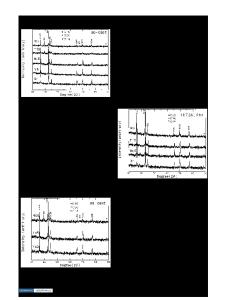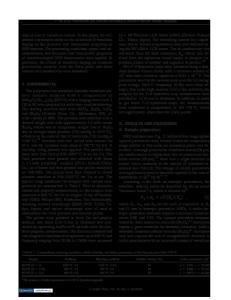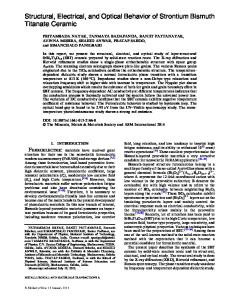Effect of Bismuth Addition on the Crystal and Electronic Structure of Strontium Molybdate
- PDF / 715,789 Bytes
- 8 Pages / 612 x 792 pts (letter) Page_size
- 0 Downloads / 257 Views
HE 100th ANNIVERSARY OF URAL FEDERAL UNIVERSITY
Effect of Bismuth Addition on the Crystal and Electronic Structure of Strontium Molybdate Z. A. Mikhaylovskayaa,b, E. S. Buyanovaa,*, E. V. Sokolenkoc, G. V. Sliusarevc, S. A. Petrovaa,d, and A. F. Zatsepina a b
Zavaritsky Institute of Geology and Geochemistry, Ural Branch, Russian Academy of Sciences, Yekaterinburg, 620016 Russia c
d
Yeltsin Ural Federal University, Yekaterinburg, 620002 Russia
North Caucasus Federal University, Stavropol, 355009 Russia
Institute of Metallurgy, Ural Branch, Russian Academy of Sciences, Yekaterinburg, 620016 Russia *e-mail: [email protected] Received March 3, 2020; revised March 25, 2020; accepted April 14, 2020
Abstract—A series of bismuth-substituted compounds based on SrMoO4 and corresponding to general formula Sr1−3xBi2xMoO4 is examined. Based on data from X-ray powder diffraction, a structural model is proposed for samples characterized by high contents of bismuth (x ≥ 0.20). The density of states near the band gap is calculated from first principles. Results from calculating the band gap width of crystals are compared to data obtained from reflection spectra.
Keywords: scheelite, strontium/bismuth molybdate, density of states DOI: 10.1134/S0036024420120201
INTRODUCTION Molybdates of alkaline earth metals and scheelitelike compounds characterized by the general formula ABO4 are characterized by a wide range of physicochemical properties and specific structural features. Such compounds are of interest as materials for, e.g., scintillators and lasers [1–3], cryogenic detectors of particles [3], heterogeneous catalysts [4, 5], luminescent systems [6, 7], electrochemical devices [8], microwave dielectrics [9]. Strontium molybdate SrMoO4 crystallizes in the scheelite structural type (space group I41/a); it consists of molybdenum–oxygen tetrahedra separated by octa-coordinated strontium atoms [10]. Strontium molybdate displays photoand electrocatalytic [11, 12], luminophore [11, 12], and dielectric properties in a wide range of frequencies [13]. The strontium in SrMoO4 can be replaced with bismuth via the formation of oxygen-excess phases of the Sr1−xBixMoO4−x/2 type (for low concentrations of bismuth, x < 0.1 [14]) or cation-deficient Sr1−3xBi2xMoO4 phases (for high concentrations of bismuth up to x < 0.25 [15, 16]. Substitution with bismuth improves the photocatalytic characteristics [14, 15], narrows the band gap, and substantially lowers the
melting and sintering temperatures of samples. In [15], considerable distortion of the structure and compression of the unit cell of strontium molybdate was observed upon doping with bismuth, and superstructural ordering was noted for compositions with high contents of bismuth (0.15 < x < 0.25 Sr1−3xBi2xMoO4). Theoretical works devoted to studying the electronic structure of SrMoO4 include those by Bi et al. [17] (where electronic structure was calculated and the photocatalytic properties of the complex oxide were confirmed) and Vali [18] (where the electronic properties and phonon
Data Loading...











